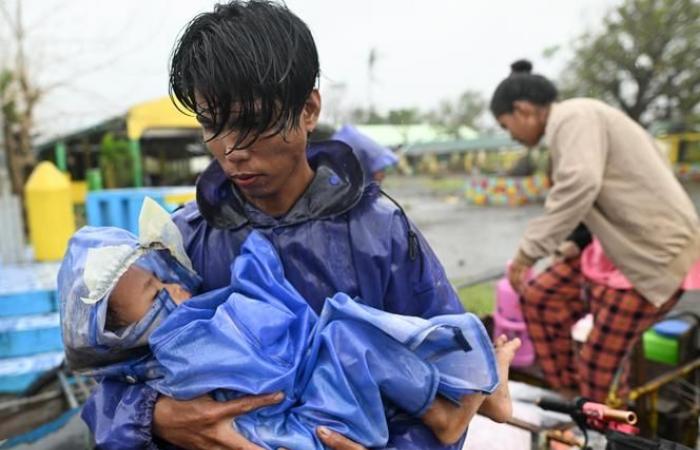The new meteorological episode comes as the country struggles to recover from the consequences of four previous typhoons. Typhoon Usagi hit the northern Philippines on Thursday, November 14, while authorities rushed to evacuate thousands of residents from coastal areas.
It made landfall in the town of Baggao, in the province of Cagayan (north of the island of Luzon), at 1:30 p.m. local time (6:30 a.m. in Paris), with winds of 175 km/h, reported the National Weather Service. The weather agency, which initially issued a maximum storm warning level on a scale of five, lowered it to the second level when the typhoon made landfall.
He said the winds could cause “almost total damage to structures made of lightweight materials, particularly in highly exposed coastal areas” et “significant damage” to buildings considered to be “low risk”. Of the “intense to torrential rain” and coastal waves that can reach up to three meters and can “endanger life” are also planned for the next two days.
The storm weakened to 165 km/h as it crossed the northern tip of Cagayan province. Baggao township police said there were no immediate reports of casualties or significant damage, while 28 residents of one village were evacuated over fears it could be flooded.
Read the decryption | Are there any differences between a typhoon, cyclone and hurricane?
Read later
President Ferdinand Marcos, who visited areas affected by the storm to distribute financial aid of 5,000 pesos to 10,000 pesos (some 80 euros to 160 euros) per family, urged residents to comply with the evacuation orders. “We know it is difficult to leave your home and belongings, but shelter can save lives”he told residents of the island of Mindoro, according to an official transcript of his speech.
“While we cannot prevent typhoons from hitting the country, we can take steps to reduce their impact”the president continued, calling for improved infrastructure to deal with the worsening effects of storms, which he attributes to climate change.
Forced evacuations
In Cagayan province, on the northern island of Luzon, authorities worked in pouring rain Thursday to evacuate residents along coasts and on the banks of already swollen rivers. “Yesterday, it was a matter of preventive evacuations. Now we are carrying out forced evacuations”Edward Gaspar, local disaster manager, declared by telephone to Agence France-Presse (AFP), a few hours before the arrival of the hurricane.
According to Rueli Rapsing, local civil protection official, some 40,000 people are expected to be sheltered, roughly the same number of people evacuated as a preventive measure before Typhoon Yinxing hit the northern coast of Cagayan earlier this month.
Newsletter
“Human warmth”
How to face the climate challenge? Every week, our best articles on the subject
Register
The official said more than 5,000 residents of the province were still in shelters after four storms that hit the Philippines in the past three weeks. After Usagi, tropical storm Man-yi is also expected to hit the capital region, Manila, further south this weekend.
Local authorities were ordered to convince residents of communities exposed to flooding and landslides in Man-yi's path to seek shelter Friday before the storm arrives, the bureau reported of civil defense.
700,000 people still homeless
“Typhoons overlap. As soon as people try to recover from the shock, the next tropical storm hits them again”lamented Gustavo Gonzalez, resident coordinator of the United Nations (UN) in the Philippines. According to a United Nations assessment of the four storms since mid-October (Trami, Kong-rey, Yinxing, Toraji), 207,000 homes have been damaged or destroyed, and nearly 700,000 people are seeking shelter. temporary.
The storms also destroyed thousands of hectares of agricultural land and persistent flooding risks delaying replanting efforts and worsening food supply problems, the report added.
The bout of weather disasters resulted in the deaths of 159 people, and the United Nations Office for Disaster Reduction requested $32.9 million in aid for 210,000 of the worst-affected survivors.
Around twenty large storms and typhoons hit the archipelago or its surrounding waters each year. Storms in the Asia-Pacific region are forming closer to shore, intensifying faster and lasting longer over land due to climate change, a recent study shows.







